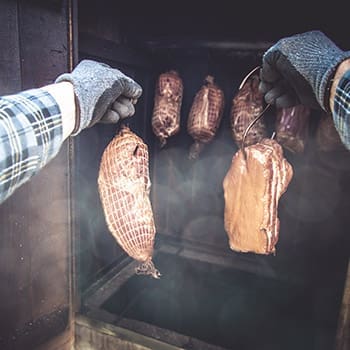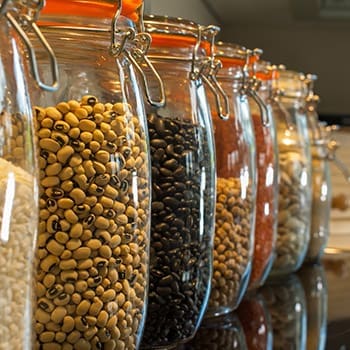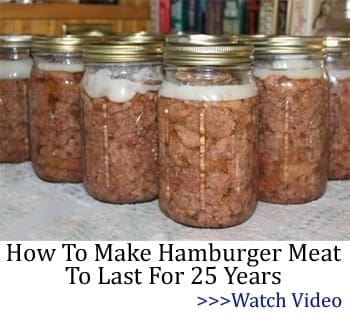When the pioneers were moving out West, they didn’t have any grocery stores, supermarkets, or restaurants they could stop by to resupply themselves as they went.
Instead, they had to stockpile foods that wouldn’t spoil and carry them on their wagons, as well as live off of the land to resupply themselves that way.
Even once the pioneers did find a plot of land on which they would build their homes, they still had to grow their own food and forage. Refrigeration, canning, and other strategies to preserve food didn’t exist back then either.
A few months ago, I got the bright idea to prepare and eat meals exactly as the pioneers did for 100 days straight.
Here’s how it went.
Why Eat Like a Pioneer?
Why did I choose to eat like a pioneer for one hundred days? Simple: I realized that in the event of a major grid-down disaster scenario, chances are good that we’ll have to eat very similarly to how the pioneers did.
Specifically, we would have to eat meals from food that we could gain from foraging and living off the land, and we would have to place an emphasis on long-lasting meals that do not require preservation.
I’m a firm believer in practicing your survival and disaster preparedness skills before you find yourself in such a survival or disaster scenario.
For instance, you should practice building a fire until you get proficient with it so a true survival situation is never the first time you have to build a fire.
All the same, I believe in practicing preparing and eating meals like you may have to after a major grid-down disaster where we no longer have access to power to cook food or grocery stores to resupply ourselves. That’s why I decided to give the pioneer diet a shot.
What Did the Pioneers Eat?
You’re probably wondering: what did the pioneers eat in the first place?
Bread
Most pioneers made their bread using the salt-rising technique, where the dough was mixed in a kettle while natural bacteria would make the dough rise.
They could then bake the dough over fires at night. Try to make your own salt-rising bread for the pioneer technique.
Related: Survival Bread To Make In An Emergency
Dried Fruits and Vegetables
Pioneers would store and transport their fruits and vegetables after drying them. To dry fruits and vegetables, pioneers would often sun-dry or air-dry them. They would slice the fruits and vegetables thinly and lay them out in the sun to remove moisture. Once dried, the fruits and vegetables could be stored for a longer period without spoiling.
This provided the pioneers with a source of vitamins and nutrients during times when fresh produce was more scarce.
Cornmeal
Cornmeal was a very versatile ingredient that could be used to make a variety of meals, including cornbread, corn pudding, and porridge. It was a readily available and economical source of nutrition for early settlers and pioneers, particularly in regions where corn was a staple crop.
The pioneers obtained cornmeal by grinding corn, which was a common and essential crop throughout North America. After settling somewhere, they would cultivate corn in their fields and then harvest the mature cobs.
The corn kernels were then removed from the cobs and dried. The dried corn kernels were then ground into a coarse powder or meal using various tools such as hand mills or grindstones.
Squash
Squash can be found naturally in the wild and doesn’t go bad very easily.
That’s why it was a big part of the pilgrims’ diet when they landed on the eastern coast of North America, and it also served the pioneers well as they were moving out west.
Meat
Meat was a big part of the pioneer diet. Most pioneers would get their meat from hunting for wild game. They would then preserve the meat either with salt curing or smoke curing.
For the pioneer diet, make sure to use unprocessed meat (either from a store or from last fall’s hunting season, if you have meat leftover). Common prey of the pioneers included elk, deer, antelope, wild boar, bear, rabbits, and squirrels.
It’s also worth noting that the pioneers would preserve the fat from the animals they killed to use as lard, which they would then use similarly to how we use olive oil today.
Related: Recipes I Made From The Lost Super Foods Book: Canned Hamburger Meat
Eggs
Eggs became a staple part of the pioneer diet after they got chickens and settled down somewhere. While some pioneers did bring chickens with them, the chickens could not lay eggs in the bumpy conditions.
When the chickens laid eggs, the pioneers used this ingenious method to preserve them and make them last for years.
Beans
The pioneers would grow beans after settling somewhere. Even while traveling, they would pack dried beans into their wagons to use as an additional source of protein with their meat.
The pioneers couldn’t be picky about what they ate.
Besides the above, they also foraged for a variety of meals along the way, including mushrooms, herbs, berries, and any other fruits, vegetables, and edibles they could find. Combining meats and vegetables together into soups and stews was also a major staple.
The Results
Switching exclusively to the pioneer diet for a hundred days was challenging, and I admit there were a few times here and there that I ‘cheated.’ When I got invited to a friend’s Saturday BBQ, for instance, I’m not going to lie that I broke from the diet to partake in ribs and cheeseburgers.
But overall, I stuck to the diet very closely for that hundred-day period. And the best thing that came out of it was my family and I proved to ourselves that we could eat self-sufficiently.
On top of that, it felt great knowing that we were eating purely natural foods. While I admit processed foods from grocery stores and restaurants taste great, we all know it’s not as healthy for us. I did notice a general increase in my energy levels and mental clarity throughout the diet.
Some of the best benefits we experienced were:
- Eating a wholesome diet every day was great for us both physically and mentally.
- Cost savings; trust me sticking purely to foods from the list I provided above saves you a lot of money instead of eating out.
- Mastering the art of cooking meals from scratch was a fun challenge. We came up with many different kinds of soups and chili’s and that was a blast.
- In that same vein, learning firsthand how to preserve different foods was a badly needed life skill that I was grateful to finally develop.
As I mentioned above, switching to this diet was challenging as well. While learning the preservation techniques was very beneficial, it took up a lot of time. It wasn’t until we embarked on this diet that my family and I finally realized just how much time and effort the pioneers spent that revolved entirely around their food preparation.
A lot of our meals were also very basic. Meats, beans, eggs, vegetables, fruits, and potatoes, among a few other food items, were on the menu every day with little variation. If you’re used to eating pasta, pizzas, burgers, noodles, and burritos whenever you want, the pioneer diet will make your taste buds crave your favorite meals.
But trust me sticking to the pioneer diet is still well worth it. You’re not going to have access to a lot of your favorite meals after a grid-down disaster, and switching to the pioneer diet just for a month or more will prove to you that you can survive with simpler meals.
Was the Challenge Worth It?
Overall, absolutely! If for nothing else, the pioneer diet is actually a lot healthier than most of what we commonly eat today, and embarking on it will help prove to you that you can prepare meals totally self-sufficiently.
If you like the thought of living in nature like the olden days, you should check out the Wilderness Long-Term Survival Guide. It’s not just any survival book; it’s a detailed guide that explores the smart ways our ancestors lived well in the wild, not just surviving but really doing well.
Much like my 100-day pioneer diet experiment, this book teaches you how to prepare for uncertain times and learn from those who made the wilderness their home.
This article first appeared here.
How The Pioneers Could Predict The Weather
The Most Powerful Medicinal Plants of our Forefathers (Video)
1800s Pioneer Items You Should Still Have At Home
Survival Hacks From The Civil War That Are More Useful Than Ever
What Livestock My Grandparents Raised During The Great Depression













I’m sure the pioneers of different ethnicities had noodles, pasta, etc. if they could make bread they could make simple “pasta” dishes.
They probably even had dried vegetables and fruits (and their seeds) from their different countries.
But the basics you covered was great
Good information and something to think about and get ideas from